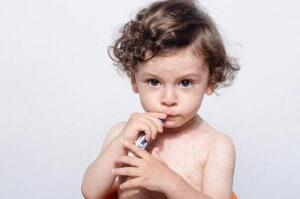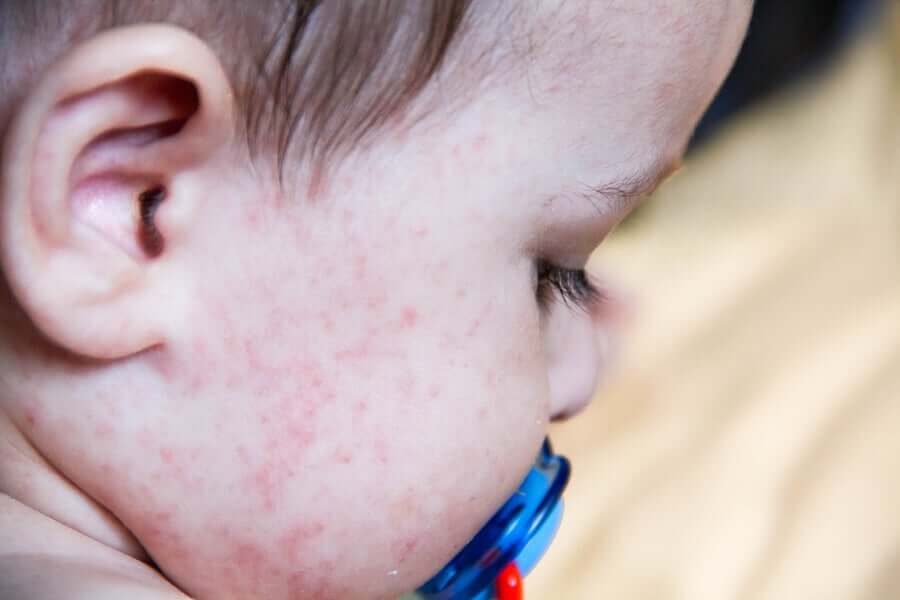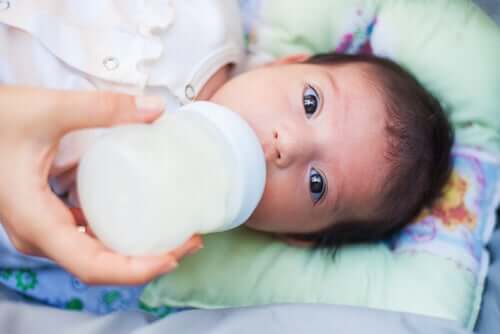Roseola in Children: What You Need to Know

Roseola is a virus that mainly affects small children between the ages of 6 months and 2 years. In general, the characteristics include high fever plus a skin rash that appears right when the fever breaks. In the following article, you’ll discover all you need to know about roseola in children. Take note.
Roseola can produce fever for 3 to 7 days. Then, a rash appears that lasts a few more days. Therefore, the illness doesn’t require treatment, except keeping the fever under control and relieving symptoms.

The first thing parents should know about roseola in children is that it’s contagious. It spreads when children with roseola talk, sneeze, or cough near someone else. The virus travels through the air in tiny drops that other children can inhale, thus catching the illness.
Roseola is only contagious during the fever stage. Therefore, once the rash appears, the illness can no longer spread.
Unfortunately, there’s no way to prevent roseola. Experts believe that having roseola during childhood immunizes individuals against the illness. This is given the fact that the virus affects children rather than adults. Unlike the chicken pox and other viral illnesses that spread quickly, roseola rarely causes an outbreak within a community.
What are the symptoms of roseola?
Roseola spreads through contact with a sick individual’s respiratory secretions or saliva. In other words, it spreads the same way a common cold does.
Most children who suffer from roseola develop a mild upper respiratory infection, followed by a week of high fever. During this time, children may not eat as much, and the glands in their throat may swell. What’s more, children are prone to feel irritable.
Some children develop very mild symptoms. In fact, some don’t even come to show clear signs of being sick. Others, however, experience the entire range of signs and symptoms. Babies run a greater risk of catching roseola because they haven’t had the chance to develop their own antibodies against the virus. The symptoms of roseola include:
- Fever: In general, this illness starts with a high and sudden fever, sore throat, and cough. The fever usually lasts between 3 and 5 days.
- Rash: Once the fever breaks, a rash normally appears, which doesn’t cause itching or discomfort. The rash can last anywhere between several hours and several days to disappear.
- Other symptoms that may appear include irritability, mild diarrhea, loss of appetite, and swollen eyelids.
How to treat roseola in children?
Roseola is usually a mild infection that primarily affects children around 2 years of age. After several days of fever, a rash usually appears. On very rare occasions, a high fever can lead to complications.
At the same time, the treatment of roseola in children includes plenty of bed rest. What’s more, children should drink plenty of water and take medication to bring down their fever. It’s important to keep children as comfortable as possible and offer plenty of liquids until they start to feel better.

Complications from roseola in children are rare. Most healthy children and adults with roseola heal quickly and completely.
No vaccine currently exists against roseola. Therefore, the best way to prevent its spreading is to avoid exposing children to those who are infected with the virus. Keep your child away from other children if he or she has (or may have) roseola. Remember that, once the fever goes down, roseola is no longer contagious.
Lastly, keeping in mind that roseola in children produces fever, it’s important to prevent dehydration. How? Encourage your little one to drink plenty of clear liquids such as water, breast milk, or formula.
In any case, if your child is sick with roseola, try not to worry too much – it’s a very common illness. However, if your child has a seizure, then seek immediate medical attention.
Roseola is a virus that mainly affects small children between the ages of 6 months and 2 years. In general, the characteristics include high fever plus a skin rash that appears right when the fever breaks. In the following article, you’ll discover all you need to know about roseola in children. Take note.
Roseola can produce fever for 3 to 7 days. Then, a rash appears that lasts a few more days. Therefore, the illness doesn’t require treatment, except keeping the fever under control and relieving symptoms.

The first thing parents should know about roseola in children is that it’s contagious. It spreads when children with roseola talk, sneeze, or cough near someone else. The virus travels through the air in tiny drops that other children can inhale, thus catching the illness.
Roseola is only contagious during the fever stage. Therefore, once the rash appears, the illness can no longer spread.
Unfortunately, there’s no way to prevent roseola. Experts believe that having roseola during childhood immunizes individuals against the illness. This is given the fact that the virus affects children rather than adults. Unlike the chicken pox and other viral illnesses that spread quickly, roseola rarely causes an outbreak within a community.
What are the symptoms of roseola?
Roseola spreads through contact with a sick individual’s respiratory secretions or saliva. In other words, it spreads the same way a common cold does.
Most children who suffer from roseola develop a mild upper respiratory infection, followed by a week of high fever. During this time, children may not eat as much, and the glands in their throat may swell. What’s more, children are prone to feel irritable.
Some children develop very mild symptoms. In fact, some don’t even come to show clear signs of being sick. Others, however, experience the entire range of signs and symptoms. Babies run a greater risk of catching roseola because they haven’t had the chance to develop their own antibodies against the virus. The symptoms of roseola include:
- Fever: In general, this illness starts with a high and sudden fever, sore throat, and cough. The fever usually lasts between 3 and 5 days.
- Rash: Once the fever breaks, a rash normally appears, which doesn’t cause itching or discomfort. The rash can last anywhere between several hours and several days to disappear.
- Other symptoms that may appear include irritability, mild diarrhea, loss of appetite, and swollen eyelids.
How to treat roseola in children?
Roseola is usually a mild infection that primarily affects children around 2 years of age. After several days of fever, a rash usually appears. On very rare occasions, a high fever can lead to complications.
At the same time, the treatment of roseola in children includes plenty of bed rest. What’s more, children should drink plenty of water and take medication to bring down their fever. It’s important to keep children as comfortable as possible and offer plenty of liquids until they start to feel better.

Complications from roseola in children are rare. Most healthy children and adults with roseola heal quickly and completely.
No vaccine currently exists against roseola. Therefore, the best way to prevent its spreading is to avoid exposing children to those who are infected with the virus. Keep your child away from other children if he or she has (or may have) roseola. Remember that, once the fever goes down, roseola is no longer contagious.
Lastly, keeping in mind that roseola in children produces fever, it’s important to prevent dehydration. How? Encourage your little one to drink plenty of clear liquids such as water, breast milk, or formula.
In any case, if your child is sick with roseola, try not to worry too much – it’s a very common illness. However, if your child has a seizure, then seek immediate medical attention.
All cited sources were thoroughly reviewed by our team to ensure their quality, reliability, currency, and validity. The bibliography of this article was considered reliable and of academic or scientific accuracy.
- Craddock, D. (1955). “Roseola Infantum”, British Medical Journal, 29 (7): 362-366.
- Stoeckle, M. Y. (2000). “The spectrum of human herpesvirus 6 infection: from roseola infantum to adult disease”, Annu. Rev. Med., 51: 423-430.
- Stone, R. C.; Micali, G. A., & Schwartz, R. A. (2014). “Roseola infantum and its causal human herpesviruses”, International Journal of Dermatology, 53 (4): 397-403.
This text is provided for informational purposes only and does not replace consultation with a professional. If in doubt, consult your specialist.








